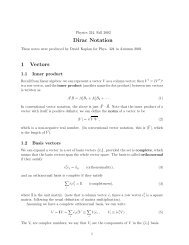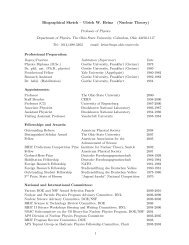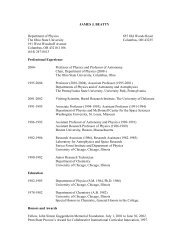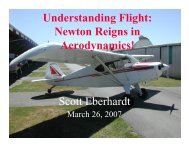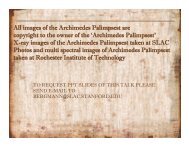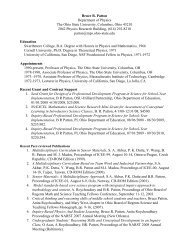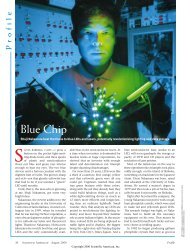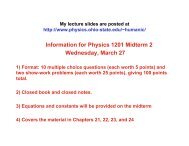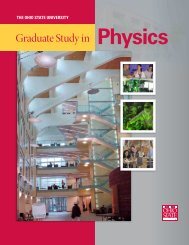Maxwell Garnett theory for mixtures of anisotropic inclusions ...
Maxwell Garnett theory for mixtures of anisotropic inclusions ...
Maxwell Garnett theory for mixtures of anisotropic inclusions ...
You also want an ePaper? Increase the reach of your titles
YUMPU automatically turns print PDFs into web optimized ePapers that Google loves.
8044 OHAD LEVY AND DAVID STROUD<br />
56<br />
FIG. 6. Real and imaginary parts <strong>of</strong> e <strong>for</strong> <strong>mixtures</strong> <strong>of</strong> randomly<br />
oriented <strong>inclusions</strong>, Eq. 17, with Eq. 43 <strong>for</strong> and Eq. 39 <strong>for</strong><br />
h . The different lines are <strong>for</strong> different values <strong>of</strong> p as in Fig. 6.<br />
To apply this approximation to the examples discussed in<br />
Sec. II A, we solve Eq. 14 <strong>for</strong> e and compute the specified<br />
derivatives. Examples are shown <strong>for</strong> <strong>inclusions</strong> aligned parallel<br />
solid curve and perpendicular dashed curve to the<br />
applied field and <strong>for</strong> randomly oriented <strong>inclusions</strong> dotted<br />
line. The results <strong>for</strong> different combinations <strong>of</strong> iijj , with<br />
volume fraction f 1/3, are shown in Figs. 7–9. In Fig. 7 it<br />
is assumed that only par ,0. Results <strong>for</strong> the case<br />
where only per ,0 are shown in Fig. 8, and results<br />
<strong>for</strong> mix ,0 are shown in Fig. 9. Clearly, whichever<br />
component <strong>of</strong> is nonzero, e is substantially enhanced at<br />
appropriate frequencies. In this approximation, the lowfrequency<br />
enhancement <strong>of</strong> per in particular is huge. The<br />
physical origin <strong>of</strong> this enhancement is a large increase in<br />
local electric fields at the interface between the <strong>inclusions</strong><br />
and the isotropic host. The uniaxial high-dielectric-constant<br />
direction predominates in carrying displacement current inside<br />
the <strong>inclusions</strong>. But within the EMA, the host is exactly<br />
at the percolation threshold <strong>for</strong> carrying displacement current.<br />
The MG approximation then predicts a large local field<br />
enhancement in the low-conductivity crystal directions.<br />
There<strong>for</strong>e, e , which depends on the fourth power <strong>of</strong> the<br />
local electric field, is greatly increased. The enhancement<br />
would be larger in systems where the contrast between <br />
FIG. 7. Real and imaginary parts <strong>of</strong> the nonlinearity coefficient<br />
<strong>for</strong> a mixture where only par ,0. Shown are results derived<br />
from the component parallel solid line and perpendicular dashed<br />
line to the applied field <strong>of</strong> Eq. 15, and the dielectric coefficient <strong>of</strong><br />
a mixture <strong>of</strong> randomly oriented <strong>inclusions</strong>, Eq. 17 dotted line<br />
with a polycrystalline host <strong>of</strong> Eq. 38.<br />
and is larger. It would be smaller <strong>for</strong> examples were the<br />
isotropic host is taken to be above the percolation threshold<br />
such as in Eq. 39 and in cases where the contrast between<br />
and is smaller.<br />
V. DISCUSSION<br />
We now consider to what extent our results may be consistent<br />
with experimental observations on various quasi-onedimensional<br />
conducting polymers. Kohlman et al. 22,23 have<br />
recently studied the dielectric response <strong>of</strong> polypyrrole and<br />
polyaniline over a broad range <strong>of</strong> frequencies from the microwave<br />
to the optical. Many <strong>of</strong> the observed features closely<br />
resemble those found here. For example, at high frequencies,<br />
they find that Re e() is positive, with a Drude-like frequency<br />
dependence. As the frequency is reduced, they observe<br />
a zero crossing followed by a broad frequency range in<br />
which Re e() is negative. At still lower frequencies, there is<br />
generally a second zero crossing below which Re e() is




